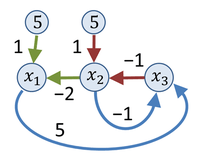Flow graph (mathematics)
A flow graph is a form of digraph associated with a set of linear algebraic or differential equations:[1][2]
- "A signal flow graph is a network of nodes (or points) interconnected by directed branches, representing a set of linear algebraic equations. The nodes in a flow graph are used to represent the variables, or parameters, and the connecting branches represent the coefficients relating these variables to one another. The flow graph is associated with a number of simple rules which enable every possible solution [related to the equations] to be obtained."[1]
Although this definition uses the terms "signal flow graph" and "flow graph" interchangeably, the term "signal flow graph" is most often used to designate the Mason signal-flow graph, Mason being the originator of this terminology in his work on electrical networks.[3][4] Likewise, some authors use the term "flow graph" to refer strictly to the Coates flow graph.[5][6] According to Henley & Williams:[2]
- "The nomenclature is far from standardized, and...no standardization can be expected in the foreseeable future."
A designation "flow graph" that includes both the Mason graph and the Coates graph, and a variety of other forms of such graphs[7] appears useful, and agrees with Abrahams and Coverley's and with Henley and Williams' approach.[1][2]
A directed network – also known as a flow network – is a particular type of flow graph. A network is a graph with real numbers associated with each of its edges, and if the graph is a digraph, the result is a directed network.[8] A flow graph is more general than a directed network, in that the edges may be associated with gains, branch gains or transmittances, or even functions of the Laplace operator s, in which case they are called transfer functions.[2]
There is a close relationship between graphs and matrices and between digraphs and matrices.[9] "The algebraic theory of matrices can be brought to bear on graph theory to obtain results elegantly", and conversely, graph-theoretic approaches based upon flow graphs are used for the solution of linear algebraic equations.[10]
Deriving a flow graph from equations


An example of a flow graph connected to some starting equations is presented.
The set of equations should be consistent and linearly independent. An example of such a set is:[2]
Consistency and independence of the equations in the set is established because the determinant of coefficients is non-zero, so a solution can be found using Cramer's rule.
Using the examples from the subsection Elements of signal flow graphs, we construct the graph In the figure, a signal-flow graph in this case. To check that the graph does represent the equations given, go to node x1. Look at the arrows incoming to this node (colored green for emphasis) and the weights attached to them. The equation for x1 is satisfied by equating it to the sum of the nodes attached to the incoming arrows multiplied by the weights attached to these arrows. Likewise, the red arrows and their weights provide the equation for x2, and the blue arrows for x3.
Another example is the general case of three simultaneous equations with unspecified coefficients:[11]
To set up the flow graph, the equations are recast so each identifies a single variable by adding it to each side. For example:
Using the diagram and summing the incident branches into x1 this equation is seen to be satisfied.
As all three variables enter these recast equations in a symmetrical fashion, the symmetry is retained in the graph by placing each variable at the corner of an equilateral triangle. Rotating the figure 120° simply permutes the indices. This construction can be extended to more variables by placing the node for each variable at the vertex of a regular polygon with as many vertices as there are variables.
Of course, to be meaningful the coefficients are restricted to values such that the equations are independent and consistent.
See also
Further reading
- Richard A. Brualdi, Dragos Cvetkovic (2008). "Determinants". A Combinatorial Approach to Matrix Theory and Its Applications. Chapman & Hall/CRC. pp. 63 ff. ISBN 9781420082234. A discussion of the Coates and the Mason flow graphs.
References
- J. R. Abrahams, G. P. Coverley (2014). "Chapter 1: Elements of a flow graph". Signal flow analysis. Elsevier. p. 1. ISBN 9781483180700.
- Ernest J Henley, RA Williams (1973). "Basic concepts". Graph theory in modern engineering; computer aided design, control, optimization, reliability analysis. Academic Press. p. 2. ISBN 9780080956077.
- Mason, Samuel J. (September 1953). "Feedback Theory - Some Properties of Signal Flow Graphs" (PDF). Proceedings of the IRE. 41: 1144–1156. doi:10.1109/jrproc.1953.274449.
- SJ Mason (July 1956). "Feedback Theory-Further Properties of Signal Flow Graphs" (PDF). Proceedings of the IRE. 44 (7): 920–926. doi:10.1109/JRPROC.1956.275147. On-line version found at MIT Research Laboratory of Electronics.
- Wai-Kai Chen (May 1964). "Some applications of linear graphs" (PDF). Coordinated Science Laboratory, University of Illinois, Urbana.
- RF Hoskins (2014). "Flow-graph and signal flow-graph analysis of linear systems". In SR Deards (ed.). Recent Developments in Network Theory: Proceedings of the Symposium Held at the College of Aeronautics, Cranfield, September 1961. Elsevier. ISBN 9781483223568.
- Kazuo Murota (2009). Matrices and Matroids for Systems Analysis. Springer Science & Business Media. p. 47. ISBN 9783642039942.
- Gary Chartrand (2012). Introductory Graph Theory (Republication of Graphs as Mathematical Models, 1977 ed.). Courier Corporation. p. 19. ISBN 9780486134949.
- Frank Harary (January 1967). "Graphs and Matrices" (PDF). SIAM Review. 9 (2).
- K. Thulasiraman, M. N. S. Swamy (2011). Graphs: Theory and Algorithms. John Wiley & Sons. pp. 163 ff. ISBN 9781118030257.
- Narsingh Deo (2004). Graph Theory with Applications to Engineering and Computer Science (Reprint of 1974 ed.). Prentice-Hall of India. p. 417. ISBN 9788120301450.